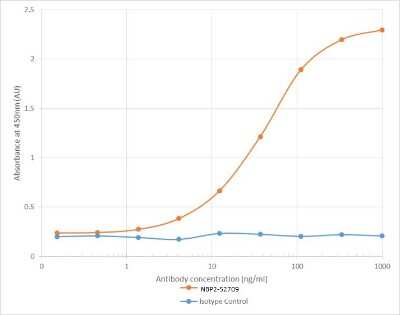Flavivirus group antigen Antibody (D1-4G2-4-15 (4G2)) - Azide and BSA Free Best Seller
Novus Biologicals, part of Bio-Techne | Catalog # NBP2-52709
Recombinant Monoclonal Antibody


Conjugate
Catalog #
Key Product Details
Species Reactivity
Validated:
Virus
Cited:
Human, Primate - Macaca mulatta (Rhesus Macaque), Virus, Virus - HPV
Applications
Validated:
CyTOF-ready, ELISA, Flow Cytometry, Immunocytochemistry/ Immunofluorescence, Immunofluorescence, Immunohistochemistry, Immunohistochemistry-Paraffin, Neutralization, Western Blot
Cited:
Block/Neutralize, ELISA, Flow Cytometry, Immunocytochemistry, Immunocytochemistry/ Immunofluorescence, Immunohistochemistry, Western Blot
Label
Unconjugated
Antibody Source
Recombinant Monoclonal Mouse IgG2a Kappa Clone # D1-4G2-4-15 (4G2)
Format
Azide and BSA Free
Concentration
1 mg/ml
Product Specifications
Immunogen
This recombinant Flavivirus group antigen Antibody (D1-4G2-4-15 (4G2)) was prepared from Dengue Virus type 2 antigens.
Reactivity Notes
Dengue Virus, Zika Virus, West Nile Virus, Yellow Fever Virus, Flaviviridae.
Specificity
This Flavivirus group antigen Antibody (D1-4G2-4-15 (4G2)) recognises flavivirus group specific antigens (Dengue virus, West Nile Virus, Japanese Encephalitis, Yellow Fever Virus, Zika virus etc). It binds to the fusion loop at the extremity of domain II of protein E.
Clonality
Monoclonal
Host
Mouse
Isotype
IgG2a Kappa
Scientific Data Images
Immunofluorescent Detection of Flavivirus group antigen in HEK 293 Cells Infected with Dengue Virus and Inhibitors
IF assay in a high throughput format for screening Dengue virus inhibitors. HEK 293 cells in DMEM 5% FBS/1% PS at 5000 cells/well are infected in presence of inhibitors with Dengue 2 New Guinea (VR-1584) using 384-well collagen-coated plates. After 48 h incubation at 37C/5% CO2, the supernatant is removed and the Alexa Fluor 647 conjugated Ab is added at 1:5250. Plates were read after O/N incubation. Columns 1-2: Cells control. 23-24, rows A-L: Cells + virus control. 23-24, rows M-P: Cells + virus control + control drug (Positive control). 3-12 and 13-22: Experimental compounds added in a dose response manner from high to low concentration (Columns 3-13 higher concentration, columns 12-22 lower concentration). Image using the Alexa Fluor 647 format of this antibody.Flow Cytometry of Infected and Uninfected C3/36 Cells Using Flavivirus group antigen Antibody
Human C3/36 cell line. Flow cytometry image submitted by a verified customer review.Flow Cytometry of Zika Virus Infected Mk2 Cells Stained with Flavivirus group antigen Antibody
Flow Cytometry: Flavivirus group antigen Antibody (D1-4G2-4-15 (4G2)) [PE] [NBP2-52709PE] - Mk2 cell line was infected with ZIKA virus at 72 p.o.i and the sample was stained and analyzed by flow cytometry. Image from verified customer review. Image using the PE form of this antibody.Applications
Application
Recommended Usage
ELISA
1:100 - 1:2000
Flow Cytometry
1:10 - 1:1000
Immunofluorescence
1:10 - 1:500
Western Blot
1:100 - 1:2000
Formulation, Preparation, and Storage
Purification
Protein A purified
Formulation
PBS
Format
Azide and BSA Free
Preservative
0.02% Proclin 300
Concentration
1 mg/ml
Shipping
The product is shipped with polar packs. Upon receipt, store it immediately at the temperature recommended below.
Stability & Storage
Store at 4C for up to 3 months. For longer storage, aliquot and store at -20C.
Background: Flavivirus group antigen
The Flavivirus group antigen antibody binds to the fusion loop at the distal end of domain II (EDII) of protein E. Flavivirus E is a glycoprotein that is the main antigen for membrane fusion between virus and host and entry into the cell, as well as inducing protective immunity by stimulating neutralizing antibodies (2, 4, 6). The E protein is 495 amino acids (aa) in length and has a theoretical molecular weight between 55 - 72 kDa, which varies based on glycosylation sites (2). Flavivirus E protein contains three domains (EDI, EDII, and EDIII) followed by a stem that contents to the helix-transmembrane domains (TMDs, TM1 and TM2) (2, 4, 6). The EDII contains an S-S bridge at its distal end and functions as a fusion loop (FL) for virus-mediated membrane fusion and antibody binding (2). Given the important role of Flavivirus protein E in host cell infection and membrane fusion, it has become a target for flavivirus disease prevention and treatment (2, 5).
Alternative names for Flavivirus group antigen include Envelope Protein and Protein E.
References
1. Ngono, A. E., & Shresta, S. (2018). Immune Response to Dengue and Zika. Annual review of immunology. https://doi.org/10.1146/annurev-immunol-042617-053142
2. Rey, F. A., Stiasny, K., Vaney, M. C., Dellarole, M., & Heinz, F. X. (2018). The bright and the dark side of human antibody responses to flaviviruses: lessons for vaccine design. EMBO reports. https://doi.org/10.15252/embr.201745302
3. Zhang, X., Jia, R., Shen, H., Wang, M., Yin, Z., & Cheng, A. (2017). Structures and Functions of the Envelope Glycoprotein in Flavivirus Infections. Viruses. https://doi.org/10.3390/v9110338
4. Laureti, M., Narayanan, D., Rodriguez-Andres, J., Fazakerley, J. K., & Kedzierski, L. (2018). Flavivirus Receptors: Diversity, Identity, and Cell Entry. Frontiers in immunology. https://doi.org/10.3389/fimmu.2018.02180
5. Boldescu, V., Behnam, M., Vasilakis, N., & Klein, C. D. (2017). Broad-spectrum agents for flaviviral infections: dengue, Zika and beyond. Nature reviews. Drug discovery. https://doi.org/10.1038/nrd.2017.33
6. Crill, W. D., & Chang, G. J. (2004). Localization and characterization of flavivirus envelope glycoprotein cross-reactive epitopes. Journal of virology, 78(24), 13975-13986. https://doi.org/10.1128/JVI.78.24.13975-13986.2004
Alternate Names
Envelope Protein, Protein E
Additional Flavivirus group antigen Products
Product Specific Notices
This product is for research use only and is not approved for use in humans or in clinical diagnosis. Primary Antibodies are guaranteed for 1 year from date of receipt.
